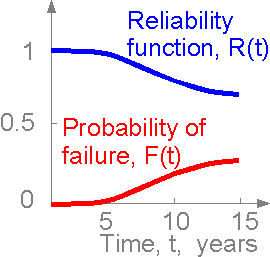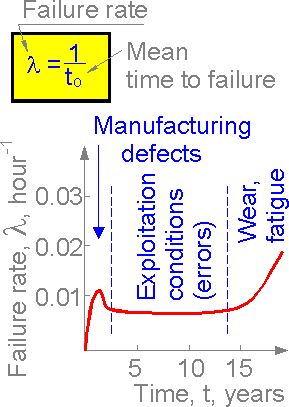Dependability is the ability of a structure to maintain its working parameters in given ranges for a stated period of time. Dependability is a collective term used to describe the availability performance and its influencing factors: reliability performance, maintainability performance and maintenance-support performance. Dependability is used only for general descriptions in non-quantitative terms.
Maintainability is a measure of the ease and rapidity with which a system can be restored to operational status following a failure.
 Reliability is the probability of component or system success under stated conditions for a stated period of time. Time to the moment when the structure fails is not exactly known. The time is a random variable. Reliability is characterized by the reliability function R(t):
Reliability is the probability of component or system success under stated conditions for a stated period of time. Time to the moment when the structure fails is not exactly known. The time is a random variable. Reliability is characterized by the reliability function R(t):
R(t) = P{t > t}
where P is the probability that the operating time to failure t exceeds the stated period of time t. Probabilities are numbers between 0 and 1.
The reliability function is related to the probability of failure function F(t) and its density function f(t):
F(t) = 1 - R(t); f(t) = d F(t) / dt = - d R(t) / dt;
The domain of the cumulative distribution function F(t) is from zero to infinity, while its range is the interval [0... 1].
 Failure rate l(t) is an important parameter of reliability.
Failure rate l(t) is an important parameter of reliability.
Every random variable has its associated cumulative distribution function. The cumulative distribution function F(t) is increasing (accumulating probability) as t increases.
If the failure rate is constant (exponential law of reliability) the dependence between failure rate and reliability function can be simplified.
 Statistical estimators of the function can be obtained by the following expressions.
Statistical estimators of the function can be obtained by the following expressions.
Here:
n(t) - number of failed elements to time t.
N - total number of elements.
to - mean time to failure.
 There is some standard behavior of the dependence curve of failure rate l versus time t:
There is some standard behavior of the dependence curve of failure rate l versus time t:
1. failures due to manufacturing defects (cracks, inappropriate materials, poor design)
2. failures due to conditions of service (exploitation errors)
3. failures due to accumulated damage (wear and fatigue)
 The figure shows typical ranges of failure rate for different engineering systems. The parameter changes over a wide range.
The figure shows typical ranges of failure rate for different engineering systems. The parameter changes over a wide range.
 2015-08-13
2015-08-13 460
460








